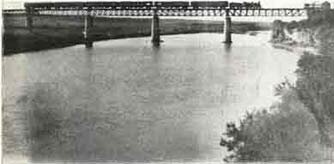Vaal Triangle History
1889 - 1902
Sharpeville
Klip Power Station
William Stow
Coal
Vereeniging
1960
1939 - 1945
Peace Negotiations
Viljoensdrift
1935
Riviera Hotel
Vereeniging History
Text (double-click to edit)
The old President was escorted by a detachment of Staatsartillerie, which however, because of time and distance, was unable to bring from Pretoria field pieces to fire the customary salute. Sammy Marks was determined that both Presidents should be suitably honoured and he organised a group of miners to explode dynamite in twenty one bottles at the prescribed intervals in imitation of the more orthodox twenty one gun salute.
With the Free State's President Reitz and his party aboard, the beflagged and decorated train steamed slowly across into the Transvaal to the formal opening ceremony held near the approach to the present road bridge. The Transvaal Advertiser recorded: "There was much decoration and ceremony. The Transvaal flag flew from one of the coal mine's chimneys, but a pole specially erected for the Union Jack had no flag as none could be found nor was there a flag of the Free State, as the delegates had forgotten to bring theirs. The President thanked them for their kind reception
With the Free State's President Reitz and his party aboard, the beflagged and decorated train steamed slowly across into the Transvaal to the formal opening ceremony held near the approach to the present road bridge. The Transvaal Advertiser recorded: "There was much decoration and ceremony. The Transvaal flag flew from one of the coal mine's chimneys, but a pole specially erected for the Union Jack had no flag as none could be found nor was there a flag of the Free State, as the delegates had forgotten to bring theirs. The President thanked them for their kind reception
The funeral train, crossing the Vaal River bridge at Vereeniging, carried President Kruger's remains back to the Transvaal after the Anglo-Boer War.
and said he was glad to see the large works and signs of other works; he hoped that it would be kept up. He did not wish them to lag behind now that the railways were here. If they did he would cut them off again. 'Ik sal julle afsnij weer'. He was afterwards the guest of Mr. Marks."
Kruger had at first opposed the extension of the railway from the south to Vereeniging. His long-held ambition had been to obtain communication with the coast which was independent of the Cape Colony and British influence.
In 1887, survey work for a rail link with Delagoa Bay in Portuguese Mozambique to the east had already begun; but following the discovery of gold on the Witwatersrand in the preceding year pressure from 'uitlander' mining houses soon mounted for a link with the Cape ports.
To protect his Delagoa Bay scheme, an agreement was reached under which the Free State would prevent any railway extension north of Bloemfontein; and this agreement was confirmed by delegates from both Republics at Potchefstroom on March 8, 1889. However, in May 1890 Kruger was forced to persuade his Volksraad to allow a line from the south over the Vaal.
In the terrible drought of 1889 wagon trains were stranded at the drifts unable to proceed because further on the grass of the open veld had wilted and there was no fodder for the oxen. The holding up of the wagon trains drastically curtailed the flow of machinery and merchandise to the Rand.
Kruger had at first opposed the extension of the railway from the south to Vereeniging. His long-held ambition had been to obtain communication with the coast which was independent of the Cape Colony and British influence.
In 1887, survey work for a rail link with Delagoa Bay in Portuguese Mozambique to the east had already begun; but following the discovery of gold on the Witwatersrand in the preceding year pressure from 'uitlander' mining houses soon mounted for a link with the Cape ports.
To protect his Delagoa Bay scheme, an agreement was reached under which the Free State would prevent any railway extension north of Bloemfontein; and this agreement was confirmed by delegates from both Republics at Potchefstroom on March 8, 1889. However, in May 1890 Kruger was forced to persuade his Volksraad to allow a line from the south over the Vaal.
In the terrible drought of 1889 wagon trains were stranded at the drifts unable to proceed because further on the grass of the open veld had wilted and there was no fodder for the oxen. The holding up of the wagon trains drastically curtailed the flow of machinery and merchandise to the Rand.
Page 11


President Kruger and President Reitz meet to open the temporary railway bridge over the Vaal river in 1892.
From the left: President Reitz, Dr. Smuts, President Kruger, A D Wolmarans, Jan Eloff, Sammy Marks, Mat Spence and Ed Burke.
From the left: President Reitz, Dr. Smuts, President Kruger, A D Wolmarans, Jan Eloff, Sammy Marks, Mat Spence and Ed Burke.
Chapter 3: The First Bridge over the River Vaal

